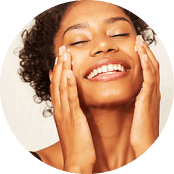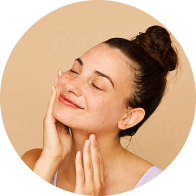
Hormonal acne can be a major pain. Just when you thought you’d got rid of acne issues for good, hormonal acne rears its head and sends your skin into a tailspin of zits, chin acne, and stress spots.
Hormonal acne break outs can lead to spots on jawline, cystic acne, and adult acne (1). And because it’s all caused by fluctuating hormones, or hormone imbalances, it can be pretty tricky to pin down and get under control.
But don’t despair. We’re here to help you understand why you might be experiencing hormonal acne, and what actions you can take to help alleviate it.
What Does Hormonal Acne Look Like?
Hormonal acne can take many forms. If you’re wondering whether a spot on your face is hormonal acne or not, consider whether it resembles any of the following:
- It’s appeared on your jawline
- You’re getting spots developing on your back or chest
- It’s a whitehead, blackhead, a papule, pustule or in more extreme cases, it’s a nodule or cyst
- Your skin is congested and dull in appearance
Why Am I Breaking Out?
Hormonal acne is often experienced by teenagers - and that’s to be expected due to the major body changes they’re going through. However, hormonal acne can also occur during your 20s and 30s - usually in women but also sometimes in men.
If you’re older and are developing acne when your skin was previously clear, this could be another sign that it’s hormonal acne - especially if you’re female and aged around 45-55. This is the time when most women generally experience the menopause and hormonal acne can be a side effect.
Lastly, if you notice you’re experiencing break outs around the same time every month, and this time ties in with your period, this is another surefire sign that your acne could be hormonal.
What Hormone Causes Oily Skin?
Androgens - which are sex hormones responsible for kicking off puberty - are often the cause of oily skin (2). There are six androgen variants and it is testosterone (the male hormone) that can cause your skin’s sebaceous glands to up their oil production.
Although testosterone is a male hormone, women also produce small quantities of it in their ovaries and their adrenal glands.
As testosterone production is upped during the menstrual cycle, women may often notice a correlation between their acne flare ups and their period.
Does Stress Cause Acne?
You want to know is stress what causes spots on face in adults? The answer, unfortunately, isn’t a straightforward ‘yes’ or ‘no’. Maybe you’ve noticed your skin gets worse at times of high stress and you think it must be the stress that’s making you break out.
However, stress in itself doesn’t cause spots. But - here’s the twist - stress does alter your hormonal balance and it can also affect your skin’s ability to protect itself. This is all down to the fact that when we’re stressed, we release the stress hormone, cortisol. This affects our sebaceous glands and makes them produce more sebum, and this, in turn, can trigger an acne flare up (3).
Therefore, there is definitely a link between stress and acne, but if you’re not predisposed to having breakouts, it’s unlikely that stress alone will cause you to experience bad skin.
What Causes Cystic Acne?
Cystic acne is considered to be the most extreme form of acne. If you’re experiencing cystic acne, you will notice -
- Lumps that are red, often painful and occur deep beneath the skin’s surface
- Spots that resemble boils
- Large pus-filled lumps
- A tendency for the skin to scar post-acne
There are multiple causes for cystic acne and they include polycystic ovarian syndrome (4), fluctuations in hormones (such as puberty), and reactions to certain medications such as steroids. You may also be predisposed to developing cystic acne due to genetics (5). Or, if you’ve been experiencing moderate acne and haven’t managed to get it under control, it’s possible that this could lead to the situation worsening and cystic acne developing.
Cystic acne is inflammatory acne that forms as a result of bacteria, sebum and dead skin cells clogging up the pores in your skin. This potent combination then causes the acne to swell and become inflamed. Not only can it be painful to touch, it can also lead to feelings of low self-esteem and confidence, as well as depression and anxiety.
When Does Acne Stop?
Acne is most common during adolescence when our bodies go through extreme changes. For females, this is usually between the years of 14 and 17, while males tend to experience it from 16 to 19.
Acne can come and go and last for several years. Some people experience acne as they go into their mid 20s, others may still have flare ups later on in life. For women, it’s also possible to experience adult-onset acne that happens as they go through the menopause.
Taming Hormonal Acne
If you’re keen to target hormonal acne, fortunately there are some things you can try at home which may ease your skin’s congestion. You could -
- Take a probiotic (6) - these help to ease gut inflammation which may be affecting your skin
- Try avoiding milk products (7) - they may have spot-producing hormones in them that make your skin worse
- Treat yourself to a chemical peel (8) - AHAs can sweep your skin clear of all those dead skin cells
- Go for a run - or try a workout - sweating could help unclog your pores, and exercise boosts your circulation which aids in easing inflammation
- Use non-comedogenic products - these won’t block your pores
How to Treat Hormonal Acne
If the condition of your skin is getting you down, and you’re constantly wondering how to clear hormonal acne, and ‘why do I get spots on my chin’, it’s probably time to consider a hormonal acne treatment to help tackle those troublesome spots.
Acne medication has come on in leaps and bounds in recent years. In contrast to a decade ago, these days it’s now possible to get a personalised acne treatment delivered directly to your door. And that’s what we offer at MiQuest - customised, expertly-formulated treatment for acne with ingredients that are formulated specifically for you.
The MiQuest system is simple. Firstly, our facial scanning technology analyses your skin so that our prescribers can diagnose your skin condition and prescribe the right formulations for you. Your acne cream subscription will be delivered to your door with a quick and easy routine you need to follow:
- Morning: cleanse, moisturise, apply your SPF
- Evening: cleanse, moisturise, apply your Q-Stick
It’s important you stick to this routine as it works to put your skin in the best possible position to soak up all the active ingredients it needs from your personalised Q-Stick. And don’t be tempted to just slather on the Q-Stick as often as possible. It works best at night when your skin is able to reset and restore as it’s not facing any daytime stressors such as pollution, anxiety, or extreme weather conditions.
As you follow your MiQuest skincare routine, we’ll be with you every step of the way. We offer check-ins to catch up and see how your skin is doing, and if we feel like you’d benefit from having your prescription ingredients altered, we’ll do that for you. We want you to see fantastic results as much as you do, so you can count on us to be here for the journey.
How to Get Tretinoin Prescription
Tretinoin is a great option when it comes to targeting acne. It’s a topical retinoid that works by boosting skin cell production. At MiQuest, tretinoin is one of our main go-to’s for acne treatment as it has multiple skin-boosting benefits such as preventing new comedones from forming, evening out skin tone, and keeping pores clear.
If you’re keen to try tretinoin for your hormonal acne break outs, or discover other active ingredients such as azelaic acid, niacinamide, and clindamycin that might be right for you, sign up for a MiQuest subscription. We’ll work with you to deliver the results you want, and all you need to do is follow our simple three-step routine.
Fancy trying it?

References:
- Shaw, J.C., 2002. Acne: effect of hormones on pathogenesis and management. American journal of clinical dermatology, 3, pp.571-578.
- Lucky, A.W., 1995. Hormonal correlates of acne and hirsutism. The American journal of medicine, 98(1), pp.S89-S94.
- Niemeier, V., Kupfer, J. and Gieler, U., 2006. Acne vulgaris–psychosomatic aspects. JDDG: Journal der Deutschen Dermatologischen Gesellschaft, 4(12), pp.1027-1036.
- Moghetti, P. and Toscano, V., 2006. Treatment of hirsutism and acne in hyperandrogenism. Best Practice & Research Clinical Endocrinology & Metabolism, 20(2), pp.221-234.
- Di Landro, A., Cazzaniga, S., Parazzini, F., Ingordo, V., Cusano, F., Atzori, L., Cutrì, F.T., Musumeci, M.L., Zinetti, C., Pezzarossa, E. and Bettoli, V., 2012. Family history, body mass index, selected dietary factors, menstrual history, and risk of moderate to severe acne in adolescents and young adults. Journal of the American Academy of Dermatology, 67(6), pp.1129-1135.
- Yu, Y., Dunaway, S., Champer, J., Kim, J. and Alikhan, A., 2020. Changing our microbiome: probiotics in dermatology. British Journal of Dermatology, 182(1), pp.39-46.
- Dai, R., Hua, W., Chen, W., Xiong, L. and Li, L., 2018. The effect of milk consumption on acne: a meta‐analysis of observational studies. Journal of the European Academy of Dermatology and Venereology, 32(12), pp.2244-2253.
- Babilas, P., Knie, U. and Abels, C., 2012. Cosmetic and dermatologic use of alpha hydroxy acids. JDDG: Journal der Deutschen Dermatologischen Gesellschaft, 10(7), pp.488-491.






AI-Empowered Dermatology, Personalised For You.





